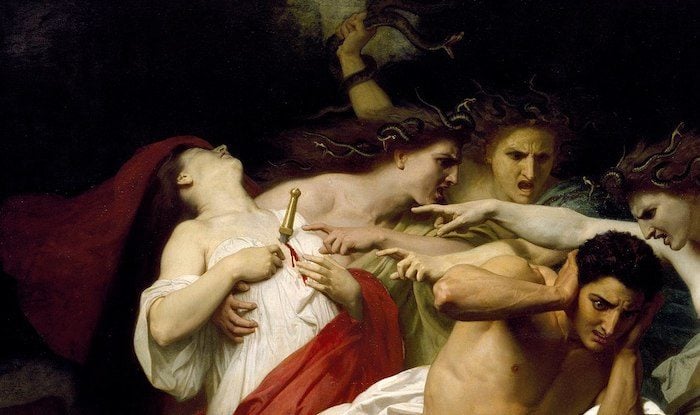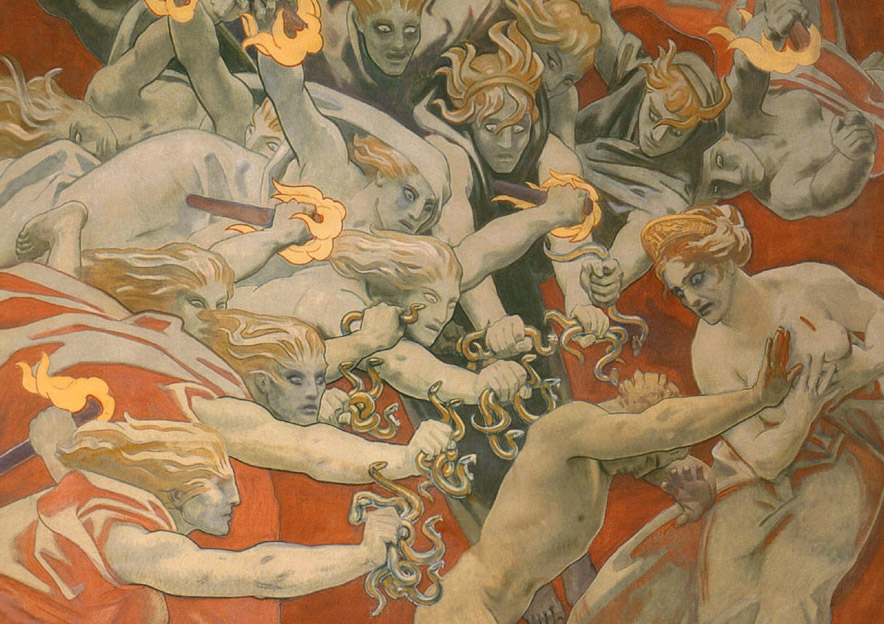
The Furies were a powerful force in ancient Greek mythology. Called the Erinyes, the furies were avenging figures who were tasked with inflicting divine vengeance on those who swore false oaths.
They most often intervened in instances in which the customs surrounding particularly important relationships in the ancient Greek world, such as that between parent and child, guest and host, and the young and old, were violated.
The Furies were significant figures in Greek mythology
Some ancient Greek authors describe the Furies as women with snakes for hair, as well as wings, and the heads of dogs. In most artistic depictions, however, they are simply shown as women with wings. They were known to strike down those who incurred their wrath.
The fearsome female figures are chthonic dieties or gods that are associated with the underworld and the soil of the Earth, as well as agriculture. Persephone, Hades, and Demeter are widely considered “chthonic.”
Hermes is also referred to as a chthonic figure due to his role as a psychopomp, or a figure who occasionally escorts the dead to the underworld.
While always referred to as a group of women, there is no set number of furies in Greek mythology. Throughout time, however, the Furies became associated with a group of three women.
This change likely occurred during the Roman period, as it is most commonly found in Roman mythology, like in Vergil’s epic poem The Aeneid, but Euripides was the first to refer to them as three women. In some sources, their names were Alecto, Megaera, and Tisiphone.
The origin of the Furies is varied in ancient sources from Greek mythology. According to Hesiod’s Theogony, an eight century genealogy of the gods, the Furies were born after the Titan Cronus castrated his father Uranus and threw his genitals into the sea.
Famously, Aphrodite herself is said to have been born from the sea foam after Uranus’ castration. Yet, Hesiod argues that the Furies were also born that day—from the drops of the primordial god’s blood that were spilled on the sandy shores.
In other accounts, the Furies were the children of Nyx, the goddess of the night, or were born from the air and Mother Earth herself.
All variations of their origin indicate that the Furies are primordial and natural, existing from the early days of the gods. This suggests that they play an essential role in the world and in society, bringing about justice when oaths are broken.
Even the etymology of their Ancient Greek name “Erinyes” (singular “Erinys”) is thought to be particularly old, as many scholars have linked to the Mycenaean script Linear B. Some classicists believe that “Erinys” may come from the Ancient Greek “eris” (ἔρις), which means strife.
Considering the ancient Greek origins of democracy and justice, it is not surprising that the Furies were considered so fearsome and significant to the ancient Greeks.
There was even a shrine to the deities under the Areopagus in Athens, the site where Athenian judicial cases were heard and where the council voted on matters of government.
The Furies were heavily linked to the goddess Nyx and were described by both Aeschylus and Euripides, two great ancient playwrights, as dark figures who only emerged during the night.
The fearsome deities of vengeance in ancient Greek literature
The Furies appear frequently in ancient Greek literature and drama, and references to the deities are found on some of the most ancient extant fragments from Greek antiquity.
In Homer’s Iliad, which tells the story of the Trojan War, the Furies are twice referred to as figures who “take vengeance on men, whosoever hath sworn a false oath”— once when Agamemnon gives Briseis, a Trojan captive, back to Achilles, and for a second time when Menelaus and Paris are set to duel over Helen of Troy.
In both instances, the Furies are invoked as a sign that the terms of the agreement will be held up when someone is making a solemn promise to someone else.
They also feature prominently in the works of ancient Greek authors, particularly Aeschylus, Euripides, and Sophocles.
Aeschylus’ Oresteia, a set of three plays (Agamemnon, The Libation Bearers, and The Eumenides) detail the story of Orestes, who kills his mother Clytemnestra for killing his father Agamemnon and is later put on trial for the act.
In the first play of the trilogy, Agamemnon, the eponymous king returns to Mycenae from the Trojan War to meet his wife, Clytemnestra, who has been stewing in her rage since he left.
Horrifically, Agamemnon sacrifices their daughter Iphigenia in order to sail to Troy after the goddess Artemis stops the winds.
Clytemnestra seeks revenge for the killing, and, with her lover and her husband’s cousin Aegisthus as an accomplice, kills her husband and Cassandra, a Trojan woman he had taken captive.
In The Libation Bearers, Orestes, the son of Clytemnestra and Agamemnon, returns home to Argos many years after the murder of his father to exact revenge on his own mother, who has since taken the throne with her lover.
On his way home, he encounters his sister, Electra, who is offering libations at their father’s grave. Together, they devise a plan to kill their mother and Aegisthus, her lover.
Orestes slips into the palace unrecognized and kills Aegisthus. When he goes to kill Clytemnestra, his mother, he hesitates, as she begs for her son to have mercy on her.
After killing her, the Furies descend upon the man for committing matricide—violating the sacred relationship between a mother and her child.
Painters throughout history frequently used the image of Orestes being tormented by the deities in their works.

The third and final work of the cycle, The Eumenides, attempts to depict how justice and the rules of judicial trials were codified in ancient Greek society.
In this work, the Furies are frequently referred to as “the Gracious Ones” (“Eumenides”) rather than as fearful entities, signaling the society’s shift toward a judicial system based on fairness rather than on vengeance but also alluding to the superstition that one must never utter their true names.
In the work, Orestes, after receiving advice from Apollo at Delphi, pleads to Athena to help him avoid the vengeance of the Furies.
The goddess of wisdom suggests that she hold a trial with a jury of Athenians to try Orestes for his crime.
In an arrangement that resembles many contemporary criminal courts today, Orestes stands accused of murder with the Furies as his accusers. Apollo serves as what could be described as Orestes’ defense attorney. Athena functions as a kind of judge.
While the trial touches on many issues, including the importance of one’s mother compared to their father and blood vengeance, it attempts to reconcile the primordial, ancient forces and traditions embodied by the Furies with the rapidly developing ancient Greek society, which was moving toward justice, as personified by the figures of Apollo and Athena.
At the end of the trial, the jury is split, and Athena casts a final, tie-breaking vote to acquit Orestes of the murder.
She then calls on the Furies to become goddesses of justice rather than vengeance and assigns them the role as protectors of her city, Athens. She then calls them the “Semnai,” or “venerable ones.”
The Furies in the works of Euripides and Sophocles
The Furies are also mentioned in Euripides version of the story of Orestes in his play called Orestes, which takes place after the murder of Clytemnestra. Like in Aeschylus’s work, the Furies are referred to as “Eumenides” in Euripides’ play.
Orestes was written to follow Euripides’ work Elektra. Many scholars contend that Euripides’ Elektra was a parody of Aeschylus’ earlier work The Libation Bearers. While primarily an author of tragedy, Euripides was known to inject elements of humor and comedy into his plays.
In this work, Agamemnon has sacrificed his daughter, and Clytemnestra has killed him after he returned from Troy.
Many years after her father’s death, Electra reaches a marriageable age and begins to meet suitors. Her mother and her lover, now on the throne, fear that any potential marriage could lead to the couple seeking revenge for the murder of Agamemnon and eventually assuming the throne.
They marry Electra to a poor farmer to avoid this, but little do they know that being cast from her home emboldens Electra even further and drives her mad with rage.
She begins to devise plans for revenge. When her brother, Orestes, who had been away for many years, crosses paths with her, the two plot the murders together with Orestes’ friend Pylades.
After Orestes kills his mother’s lover, Aegisthus, he has doubts about taking his mother’s life. Electra, however, filled with rage, convinces him to follow through with the act. After the death of their mother, the two are overcome with regret. The Furies begin to torture Orestes after the murder.
Clearly, the Furies play a significantly smaller role in Euripides’ version of the same story, but reappear in his work Orestes, which takes place after Electra.
In this work, they are depicted as torturing Orestes after the murder of his mother but are not treated as significant characters as they are in Aeschylus’ plays.
They also appear in Sophocles’ play Oedipus at Colonus, which follows the events of the great playwright’s famous work Oedipus Rex, in which the titular character kills his mother, who was also his wife.
When Oedipus received his fateful prophecy that he would kill his father and marry his mother, he was also told that he would be buried in land sacred to the Furies.
As the work takes place in the aftermath of a matricide, it comes as no surprise that the Furies make their appearance in the work, as they drive Oedipus to the point of madness.
In the play, the blind Oedipus is led into the village of Colonus by Antigone, his daughter. The villages warn him that he cannot enter the town, as it is sacred to the Furies, and that if he does enter, he must perform tasks to appease them.
The play sets up the scene for Sophocles’ next and possibly most famous play, Antigone.
The primordial, powerful Furies were important figures in Greek mythology and in ancient Greek society, and epitomized the culture’s focus on justice.
See all the latest news from Greece and the world at Greekreporter.com. Contact our newsroom to report an update or send your story, photos and videos. Follow GR on Google News and subscribe here to our daily email!



